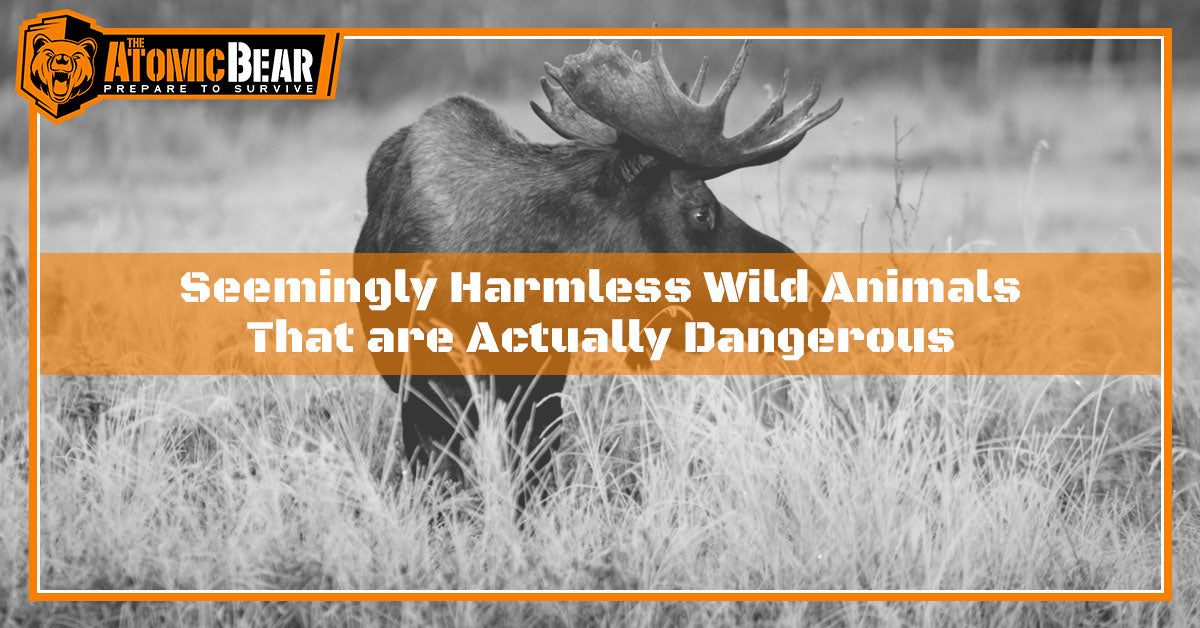
We’ve already written about encountering wild animals that are obviously dangerous, such as bears, wolves, and mountain lions. However, there are animals you could run into while in the wilderness (or even close to home) that you might not think are too dangerous. Long story short: you should never take your safety for granted when encountering any animal. However, we’re going to cover some that are commonly mistaken as docile in this article.
At The Atomic Bear, we specialize in self-protection devices and prepper essentials. Whether you’re preparing for a large-scale disaster, a devastating storm, or a self-defense situation, we have the gear you need. Shop online now.
Here are some of the surprisingly dangerous animals you might encounter in the wild.
Moose
Moose, for some reason, have been portrayed as slow, dumb animals that laze about and mosey through the forest. That couldn’t be further from the truth. These animals aren’t afraid of humans, and why should they be? They weigh well over 1,000 pounds, can run up to 30 mph, and stand at about 9 feet at the shoulder. And the males have gigantic horns. While they’re not afraid of humans, they’re not aggressive, either, unless they’re provoked or have babies nearby.
Bison
Bison is another animal that appears soft and cuddly on the outside, slightly slow, and not much of a threat. Don’t be fooled. They have been deemed one of the most dangerous animals in the United States, and attack five times more people than bears do every year. They weigh nearly 2,000 pounds, can run up to 35 mph, and once they catch up to you, they will stomp or even gore you.
Bighorn Sheep
Bighorn sheep aren’t aggressive animals by nature, but it’s an entirely different story if they’re provoked during the rutting season. Most of the time, they will ignore you (even though we never recommend approaching or going near them!). However, when you consider that their horns make up for 30 pounds of their 200-500 lb bodies, you certainly don’t want to encourage them to find a reason to attack you…especially if you’re near the edge of a mountain.
Hawks and Eagles
Just because eagles, owls, and hawks (and other large birds of prey) tend to be much higher above ground than you, that doesn’t mean they’re harmless. Depending on the species, they can grow up to three feet tall and have a wingspan of up to eight feet across. Eagles can fly at speeds up to 40-50 mph, but can dive bomb at a rate of 100 mph. Most attacks by birds of prey are on small pets they’re hoping to snack on. But those who venture near the nest can expect aggression from the hatchlings’ parents—they are very protective of their babies. Their beaks and claws are extremely strong and sharp and can easily tear through flesh.
Awareness of your behavior, as well as the animals you might encounter, is key to avoiding a dangerous encounter. Be aware of your environment, make noise so you don’t surprise an animal, and be sure to carry self-defense items just in case. The Atomic Bear is the place to shop for self-protection devices, such as our tactical defense pen and tactical flashlight. Shop online today!
 Free ground shipping on order above $150 (USA)
Free ground shipping on order above $150 (USA)



